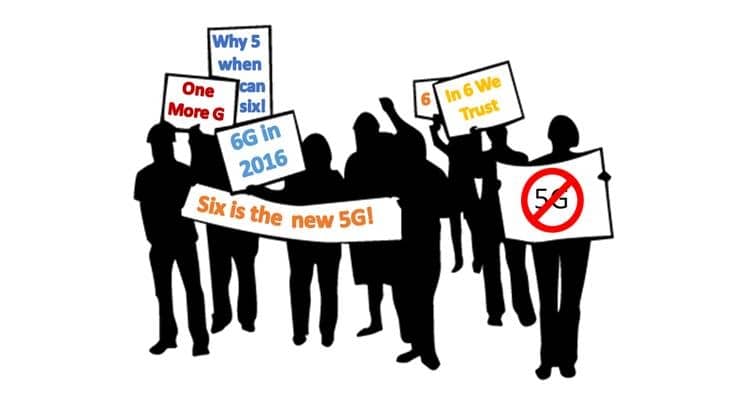I am so excited for the emergence of 6G in 2016. Who can refuse the potential of one more G? Additional Gs drive a huge amount of marketing spend, interesting research projects and give us all something to talk about at conferences.
Is there really a 6G? Of course not, but one could argue the same thing for 5G—that it’s at least ten years away from realization and is, well, mainly hype at this point.
So rather than wax poetically about some really cool new technologies, here are my top 3 telecom predictions for 2016. Let me know if you agree or beg to differ by commenting on this article.
Without further ado…
#1: CONSUMPTION-BASED PRICING COMING TO A RESIDENCE NEAR YOU
Nah nah nah nah hey hey hey goodbye to the all-you-can-eat fixed line internet service. Seems a bit terrifying and potentially a hard sell. That being said, Comcast is already quietly trialing the approach, and this can be a good thing for the consumer and operator. It is clearly a model we are familiar with from our mobile bills. It makes a lot of economic sense for both the consumer and the service provider by closely aligning the cost with the usage versus today’s model which is aligned with a target service speed. The speeds being delivered now far exceed any reasonable home usage making it increasingly more difficult to justify paying extra dollars for that 1 Gbps line.
Why is this good for consumers? First, it promotes technologies that drive consumption, reversing the trend of “intelligent traffic management.” Traffic management is a fancy way of saying “we need to manage how much you use our network,” and generally includes unpleasant techniques like “rate limiting,” “prioritization” and “offload.” Additionally, the alignment with consumption also drives the delivery of more services, closer partnerships with content providers, and a requirement to provide reliable Wi-Fi so that services do not fall apart on the last fifty feet of the network.
We already see a growing number of services coming from operators that aim to make our lives easier or safer at home. Security, automation, on-demand video, wireless video distribution and Voice over Wi-Fi are becoming the baseline for any competitive internet service provider package. This realignment of revenue with consumption only accelerates the trend and creates a strong motivation to ensure a reliable, high-quality and high-performance experience. With roughly 60 percent of consumers receiving their Wi-Fi access points from their service provider, the managed experience will extend beyond the home gateway to the wireless link. In the not-so-distant future gone will be the days of manual reboots and mysterious changes in Wi-Fi reliability due to neighbor interference.
#2: WI-FI-FIRST SERVICES GET REAL
A Wi-Fi-first service is a low-cost mobile plan that relies primarily or exclusively on Wi-Fi. The most famous and well known of these is GoogleFi, which looks to maximize time on Wi-Fi but uses T-Mobile and Sprint networks when Wi-Fi is not available. Upstarts in the market include Scratch and Republic Wireless and even the CableCos are in the mix with Cablevision’s Freewheel service. To date these services have been more interesting to talk about than a real thorn in the side of the major Mobile Network Operators (MNOs).
That will change in 2016 and not because of Google, Scratch or Republic. The problem with Wi-Fi first has been a disconnect between the network and the service provider – essentially leaving the quality of experience wholly unmanaged in exchange for a really low-to-no-cost plan, a pure “you get what you pay for” approach. GoogleFi has focused on providing utility via the “app” on the phone itself and by having intelligence built-in for network selection. However, mobile virtual network operators’ (MVNOs) fees are very expensive so the ability to make the business case relies heavily on maximizing the time spent on the Wi-Fi network. However, if you maximize the time on an unmanaged and unreliable network, eventually customers will find the service frustrating and scurry back to the MNOs. You already see Google potentially laying the groundwork to tackle this disconnect via its expanding fiber rollout and intelligent Wi-Fi AP – the OnHub.
That being said, I do not think it is Google that will create the pain or drive a competitive response in the MNOs, but rather cable companies. First, they have the largest Wi-Fi footprint to leverage and this is growing dramatically with the broad deployment of homespots (i.e., Wi-Fi router which transmits both your private network and the operators’ public network). Second, they have to rely on Wi-Fi to deliver services – voice or otherwise – in the home and on the move so they are motivated to increase the Quality of Experience (QoE) of these networks. The MNOs will have a choice – get on board and leverage their own Wi-Fi footprint to capture and/or defend their market share of price-sensitive customers or lose a chunk of their valuation.
Todd Mersch,
Co-Founder & EVP, Sales & Marketing,
XCellAir

#3: LTE + UNLICENSED REACHES THE MOUNTAIN TOP…OF HYPE
LTE Unlicensed has captured the imagination of the market in a big way the last twelve months, and I doubt that will subside in 2016. To me, this is just another marketing spin on multi-mode small cells. Fundamentally, the wireless industry has to find a way to use all spectrum at its disposal whether it be licensed or unlicensed. The multiple variations being debated in the great unlicensed battles of 2015 are just different approaches to dealing with the inevitability of tighter integration between unlicensed and licensed spectrum in mobile networks.
I’ll attempt to add some rationality into the hype conversation. First of all, whatever LTE plus unlicensed religion you ascribe to (e.g. LTE-License Assisted Access, LTE Wi-Fi Link Aggregation, LTE-Unlicensed, deployment in 3.5 Ghz), they all fundamentally depend on the deployment of small cells. Last time I checked we were still plodding along on the slow march towards large-scale small cell deployments. It is the classic crawl, walk, then run scenario, but as usual we want to run, trip and limp.
2016 Trends and Outlook Polls
Setting aside this fundamental timing issue there is a brewing regulatory battle over the maligned LTE-Unlicensed (LTE-U) variation. LTE-U proposes to have LTE transmit in unlicensed spectrum, which rightfully has Wi-Fi-reliant service providers a bit concerned. LTE is designed to dominate the spectrum it is given. Wi-Fi is designed to fair share. I am sure there is a way to adjust LTE behavior to play nice, and the Wi-Fi-reliant service providers will lobby hard for regulators to get involved to ensure that is the case. In the end, regulators may stay out of it. This has been the case with unlicensed spectrum in the past, with regulators falling back on the broad rules of engagement for unlicensed spectrum. However, until that becomes abundantly clear no MNO is going to invest to deliver commercial LTE-U services.
Will any of this stop the promotion, conference debates or articles? Not likely. So for me this topic will dominate throughout the year, but when the dust settles at the end of 2016 the market will be excited to see a lot of LTE-only small cells and carrier Wi-Fi deployed. While the effective use of unlicensed spectrum remains inevitable and even critical to the evolution of mobile networks, it will be more effective utilization and tighter integration of Wi-Fi that set the foundation in 2016.
Whether or not these predictions prove true it will be another wild ride next year. The pace of technology evolution continues to increase in telecommunications, which is good for us in the industry and the consumers we ultimately serve. So, here’s to 6G in ’16.
About The Author:
At XCellAir, Todd is responsible for worldwide sales, product management and marketing. Prior to founding XCellAir, he spent nine years leading the Trillium software business at both Continuous Computing and Radisys. Todd focused Trillium on providing software and services for both 3G and LTE small cells, including enabling the world’s first LTE small cell deployments. He has been a thought leader and evangelist of small cells for more than eight years. He holds both a BS in Systems Engineering from the University of Virginia and a MS in Systems Architecture from the University of Southern California.



















